Transformer Testing By Your Name Date
Added on 2022-10-19
28 Pages6844 Words412 Views
University
Transformers Testing
By
Your Name
Date
Page 1 of 28
© <Your Name> 2012
Transformers Testing
By
Your Name
Date
Page 1 of 28
© <Your Name> 2012
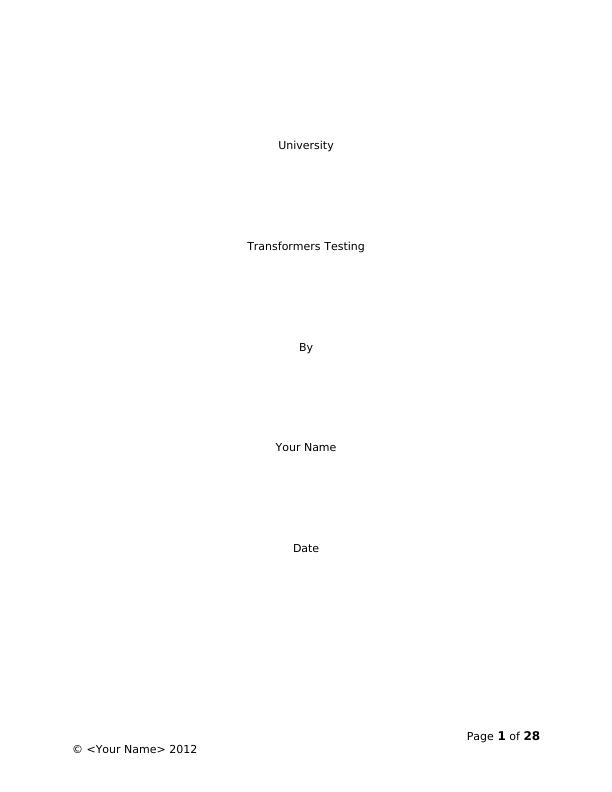
Table of Contents
1.0 Executive Summary....................................................................................... 4
1.1 Introduction...................................................................................................... 4
2.0 Literature Review............................................................................................. 5
2.1 Transformer Basics....................................................................................... 5
2.2 Applications of Power Transformers..........................................................6
2.3 Major Faults in Transformers......................................................................6
3.0 Transformer Testing........................................................................................ 7
3.1 Reasons for Testing Transformers.............................................................7
3.2 Methods of Testing Three Phase Transformers.......................................8
3.2.1 Factory Tests........................................................................................... 8
3.2.1.1 Special Tests..................................................................................... 8
Open Circuit Test........................................................................................ 8
Short Circuit Test....................................................................................... 9
3.2.1.2 Type Tests and routine tests.......................................................10
Winding Resistance Test.........................................................................11
Magnetic Balance Test............................................................................12
Transformer Ratio Test...........................................................................13
Induced Voltage Test............................................................................... 13
Temperature Rise Test............................................................................14
Vector Group Test.................................................................................... 14
Insulation Resistance Test/ Megger Test.............................................14
Dielectric Test........................................................................................... 15
Magnetizing Current Test.......................................................................16
Power Factor Test.................................................................................... 17
Polarity Test.............................................................................................. 17
Phase Relation Test................................................................................. 17
Oil tests...................................................................................................... 18
3.2.2 Site Tests............................................................................................... 18
3.3 Equipment’s Used in Transformer Testing.............................................19
Digital Resistance Meters.......................................................................19
Insulation Tester/ Megger.......................................................................19
Page 2 of 28
© <Your Name> 2012
1.0 Executive Summary....................................................................................... 4
1.1 Introduction...................................................................................................... 4
2.0 Literature Review............................................................................................. 5
2.1 Transformer Basics....................................................................................... 5
2.2 Applications of Power Transformers..........................................................6
2.3 Major Faults in Transformers......................................................................6
3.0 Transformer Testing........................................................................................ 7
3.1 Reasons for Testing Transformers.............................................................7
3.2 Methods of Testing Three Phase Transformers.......................................8
3.2.1 Factory Tests........................................................................................... 8
3.2.1.1 Special Tests..................................................................................... 8
Open Circuit Test........................................................................................ 8
Short Circuit Test....................................................................................... 9
3.2.1.2 Type Tests and routine tests.......................................................10
Winding Resistance Test.........................................................................11
Magnetic Balance Test............................................................................12
Transformer Ratio Test...........................................................................13
Induced Voltage Test............................................................................... 13
Temperature Rise Test............................................................................14
Vector Group Test.................................................................................... 14
Insulation Resistance Test/ Megger Test.............................................14
Dielectric Test........................................................................................... 15
Magnetizing Current Test.......................................................................16
Power Factor Test.................................................................................... 17
Polarity Test.............................................................................................. 17
Phase Relation Test................................................................................. 17
Oil tests...................................................................................................... 18
3.2.2 Site Tests............................................................................................... 18
3.3 Equipment’s Used in Transformer Testing.............................................19
Digital Resistance Meters.......................................................................19
Insulation Tester/ Megger.......................................................................19
Page 2 of 28
© <Your Name> 2012
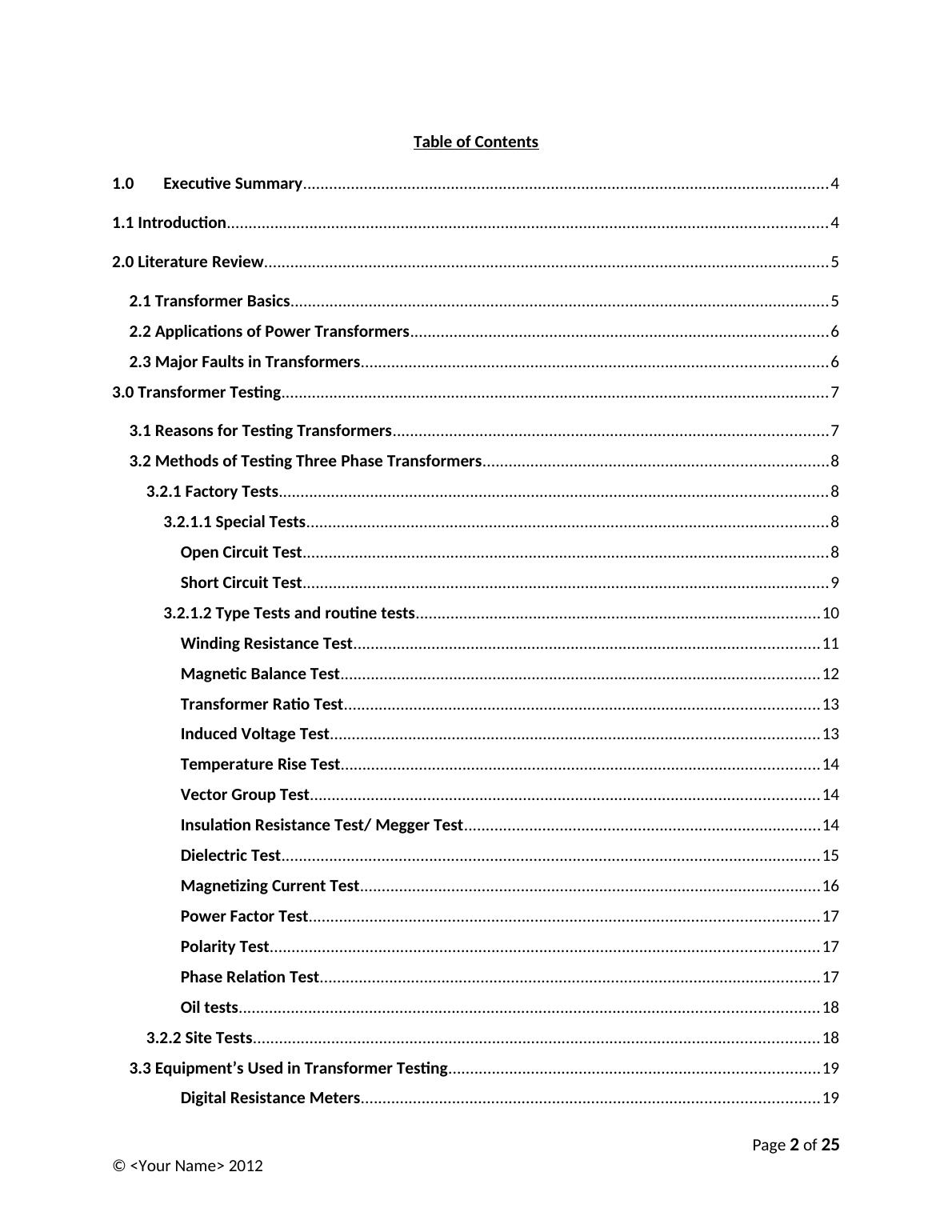
High Voltage tester.................................................................................. 19
Motor generator set................................................................................. 19
Turns Ratiometer...................................................................................... 20
Wattmeter and Power analyzers...........................................................20
Voltmeter................................................................................................... 20
Oil BDV test set........................................................................................ 20
3.4 Safety Precautions Applied in Transformer Testing.............................20
4.0 Conclusion....................................................................................................... 21
5.0 References....................................................................................................... 23
Page 3 of 28
© <Your Name> 2012
Motor generator set................................................................................. 19
Turns Ratiometer...................................................................................... 20
Wattmeter and Power analyzers...........................................................20
Voltmeter................................................................................................... 20
Oil BDV test set........................................................................................ 20
3.4 Safety Precautions Applied in Transformer Testing.............................20
4.0 Conclusion....................................................................................................... 21
5.0 References....................................................................................................... 23
Page 3 of 28
© <Your Name> 2012
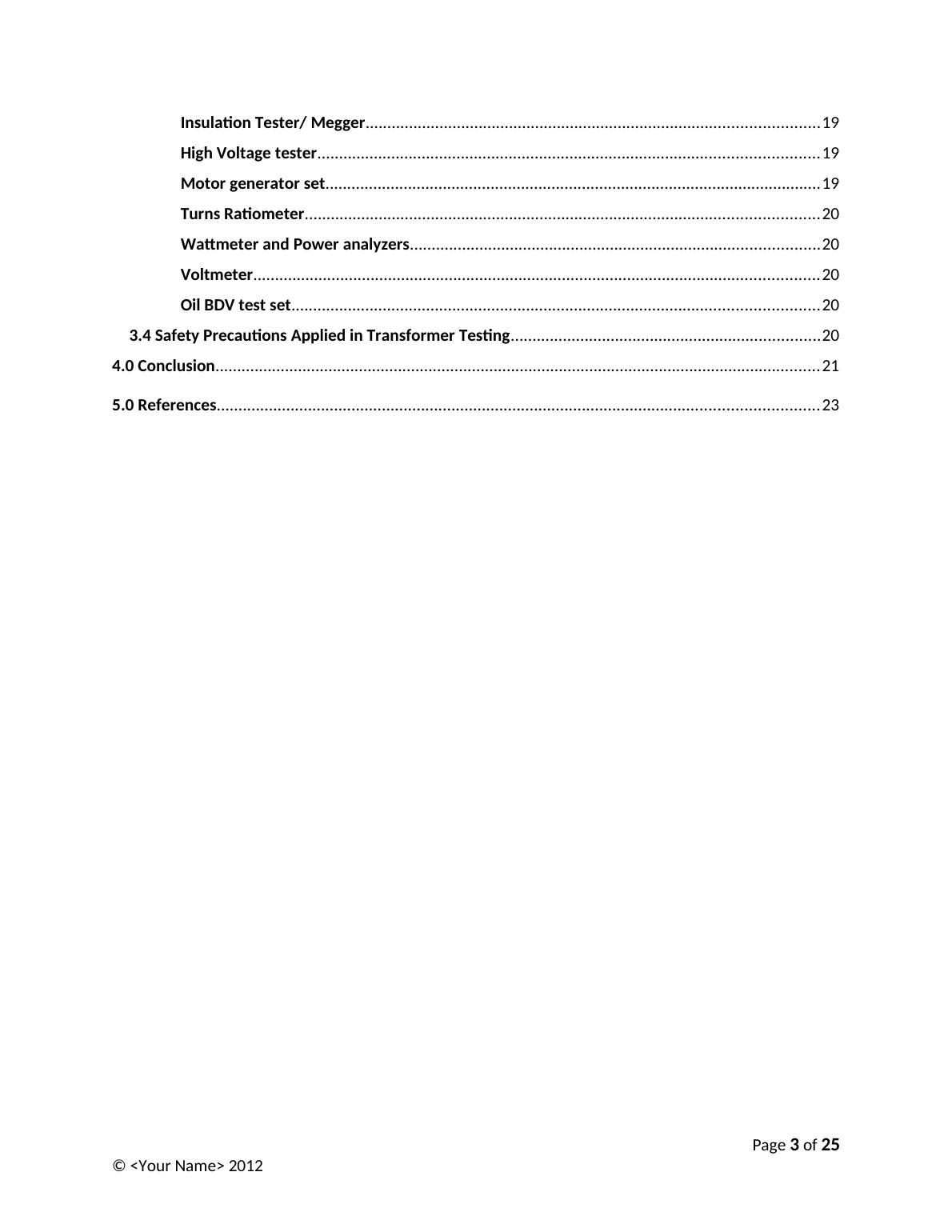
How to Test Three Phase Transformers
1.0 Executive Summary
Transformers are the most expensive, risky and important electrical machines used
in the transmission and distribution of electrical energy. As a result, the safety of
any the safety of any transformer is given key priority before and after installation.
Through the use of specialized tools and systems, different tests are conducted to
ensure that the transformer is suitable for operation and that it operates at the
highest levels of safety and efficiency possible. Transformers test can be carried out
at the factory or they can be carried out at the site of installation. Test performed at
the factory are the type-test, routine tests and the special test. They are performed
to ensure that the transformer conforms with the operation and performance
criteria. On the other hand, test conducted at the point of installation are the pre-
commissioning test, the emergency test and the periodic monitoring test. They are
conducted to ensure that the transformer performs at the expected level with no
down time and does not pose any harm to the end user.
1.1 Introduction
Transformers are static electrical devices that are used in the transmission and
distribution of electrical energy from a generating source to the end user. In an
electrical systems transformer transform electric power in one circuit to another
circuit within the system. The transformation process can either involve raising or
lowering the voltage. Transformers that raise the voltage are known as step up
transformers while those that lower the voltage are known as step down
transformers. Transformers are very expensive and hazardous, as a result various
tests are performed to determine how suitable, effective and safe the transformers
Page 4 of 28
© <Your Name> 2012
1.0 Executive Summary
Transformers are the most expensive, risky and important electrical machines used
in the transmission and distribution of electrical energy. As a result, the safety of
any the safety of any transformer is given key priority before and after installation.
Through the use of specialized tools and systems, different tests are conducted to
ensure that the transformer is suitable for operation and that it operates at the
highest levels of safety and efficiency possible. Transformers test can be carried out
at the factory or they can be carried out at the site of installation. Test performed at
the factory are the type-test, routine tests and the special test. They are performed
to ensure that the transformer conforms with the operation and performance
criteria. On the other hand, test conducted at the point of installation are the pre-
commissioning test, the emergency test and the periodic monitoring test. They are
conducted to ensure that the transformer performs at the expected level with no
down time and does not pose any harm to the end user.
1.1 Introduction
Transformers are static electrical devices that are used in the transmission and
distribution of electrical energy from a generating source to the end user. In an
electrical systems transformer transform electric power in one circuit to another
circuit within the system. The transformation process can either involve raising or
lowering the voltage. Transformers that raise the voltage are known as step up
transformers while those that lower the voltage are known as step down
transformers. Transformers are very expensive and hazardous, as a result various
tests are performed to determine how suitable, effective and safe the transformers
Page 4 of 28
© <Your Name> 2012
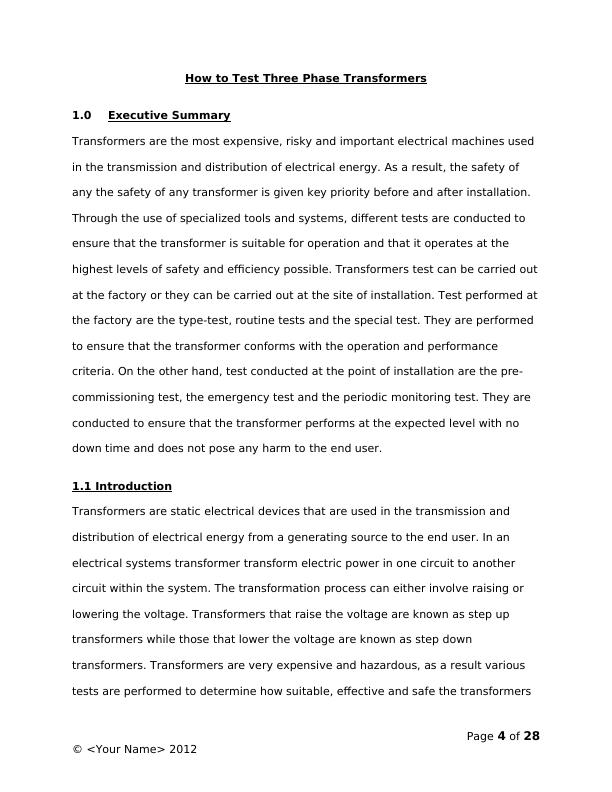
can handle their tasks in the electrical circuit. The purpose of the paper is to
present the most efficient and effective the methods of testing three-phase
transformers and how they are conducted to ensure that the transformers are safe,
effective and operate at the highest efficiency possible.
2.0 Literature Review
2.1 Transformer Basics
A transformer is a static electrical machine that transforms electric power from one
circuit to another without changing the frequency [1]. During the transformation
process, a transformer can either raise or lower the voltage from one circuit to the
other. Transformers that raise the voltage are known as step-up transformers while
transformers that lower the voltage are known as step down transformers [2]. The
basic construction of a transformer comprises two electrically separated but
magnetically connected inductive coils that are linked via a low reluctance path.
The coil connected to the supply is the primary winding while the coil in which the
electric energy is drawn out is known as the secondary winding. The transformers
operate on the principle of mutual induction between the windings that are linked
by a common magnetic flux [3]. When the primary winding is connected to the
alternating source of voltage, alternating flux in created in the laminated cores and
it is linked to the secondary winding producing a mutually induces emf in the
process. If the secondary winding is closed, current flows through and energy is said
to have been transferred magnetically from the primary to the secondary winding
[4]. The figure below shows the basic construction of transformer.
Page 5 of 28
© <Your Name> 2012
present the most efficient and effective the methods of testing three-phase
transformers and how they are conducted to ensure that the transformers are safe,
effective and operate at the highest efficiency possible.
2.0 Literature Review
2.1 Transformer Basics
A transformer is a static electrical machine that transforms electric power from one
circuit to another without changing the frequency [1]. During the transformation
process, a transformer can either raise or lower the voltage from one circuit to the
other. Transformers that raise the voltage are known as step-up transformers while
transformers that lower the voltage are known as step down transformers [2]. The
basic construction of a transformer comprises two electrically separated but
magnetically connected inductive coils that are linked via a low reluctance path.
The coil connected to the supply is the primary winding while the coil in which the
electric energy is drawn out is known as the secondary winding. The transformers
operate on the principle of mutual induction between the windings that are linked
by a common magnetic flux [3]. When the primary winding is connected to the
alternating source of voltage, alternating flux in created in the laminated cores and
it is linked to the secondary winding producing a mutually induces emf in the
process. If the secondary winding is closed, current flows through and energy is said
to have been transferred magnetically from the primary to the secondary winding
[4]. The figure below shows the basic construction of transformer.
Page 5 of 28
© <Your Name> 2012
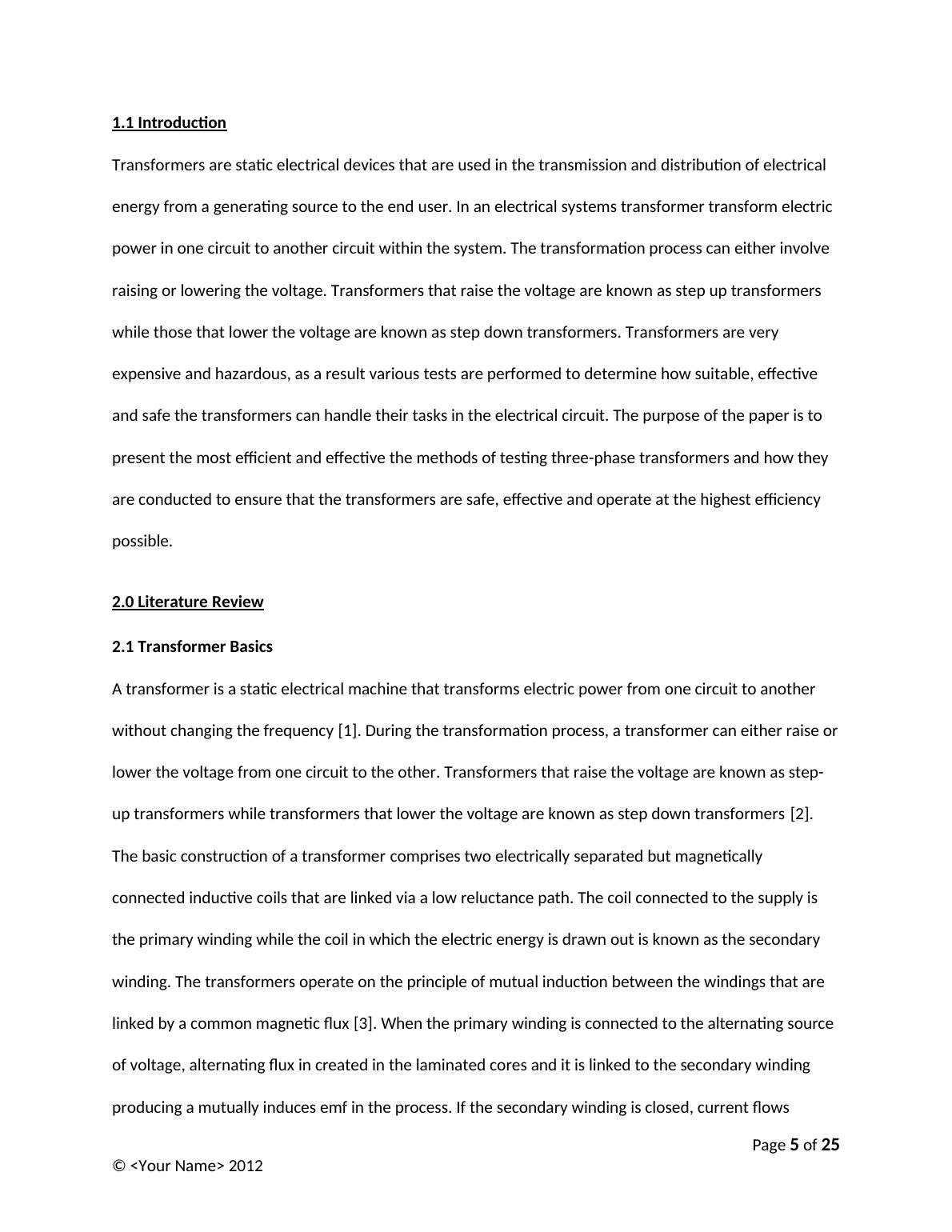
Figure 1: Basic Structure of A transformer
2.2 Applications of Power Transformers
Single phase and three phase transformers are normally used to step up or step-
down voltages of different magnitudes. Single phase voltages are applied in small
scale applications majorly in small electronic devices while three phase
transformers are applied are applied in commercial and industrial use. Besides
industrial use, three phase transformers are commonly used in the transmission and
distribution of electricity form the generation point to the utilization point.
Transformers used for transmission and distribution can either be star or delta
connected depending on where in the system it performs the duty of stepping or
stepping down the voltage [5]. A pictorial representation of a three-phase
transformer and its major components is shown below.
Figure 2: Three Phase Power Transformer
Page 6 of 28
© <Your Name> 2012
2.2 Applications of Power Transformers
Single phase and three phase transformers are normally used to step up or step-
down voltages of different magnitudes. Single phase voltages are applied in small
scale applications majorly in small electronic devices while three phase
transformers are applied are applied in commercial and industrial use. Besides
industrial use, three phase transformers are commonly used in the transmission and
distribution of electricity form the generation point to the utilization point.
Transformers used for transmission and distribution can either be star or delta
connected depending on where in the system it performs the duty of stepping or
stepping down the voltage [5]. A pictorial representation of a three-phase
transformer and its major components is shown below.
Figure 2: Three Phase Power Transformer
Page 6 of 28
© <Your Name> 2012
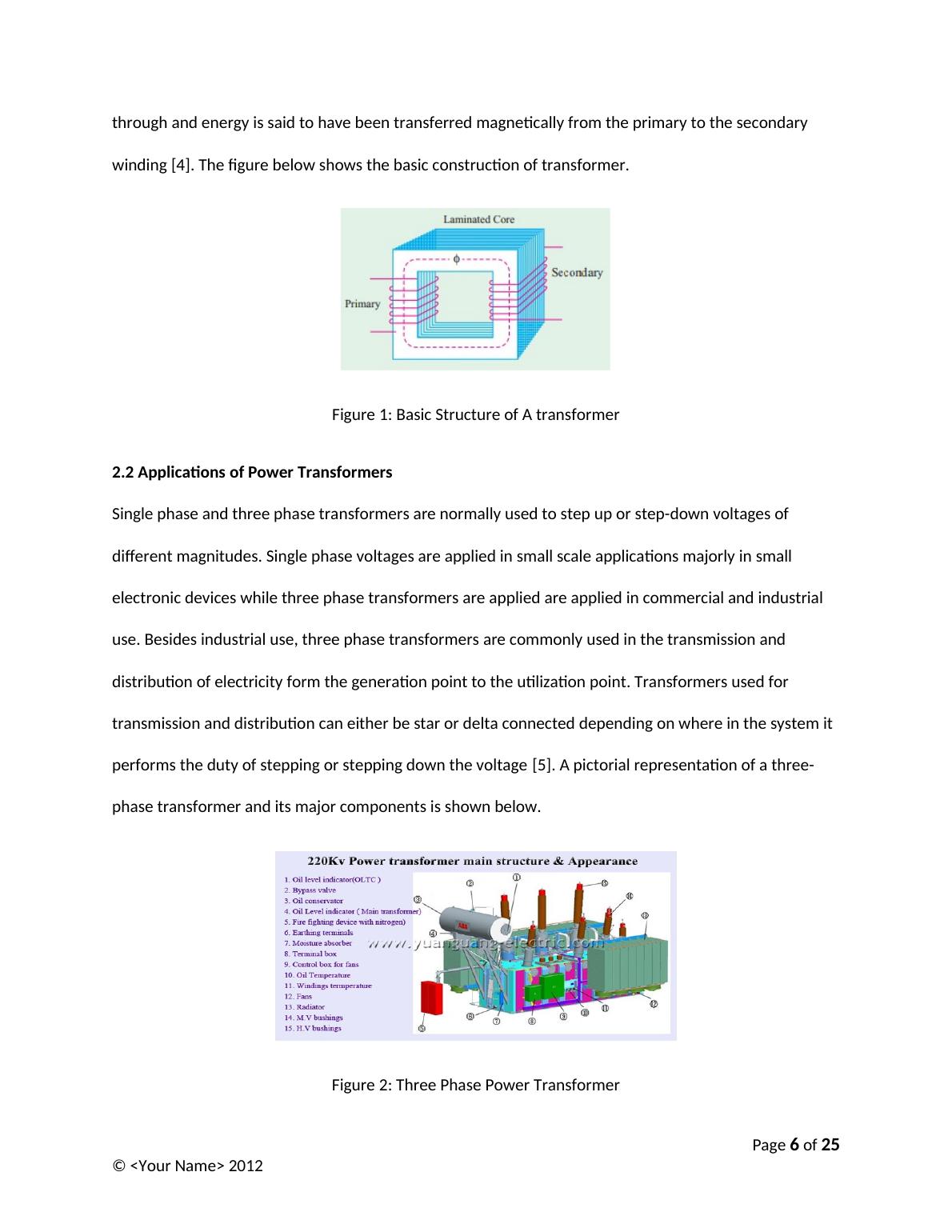
End of preview
Want to access all the pages? Upload your documents or become a member.
Related Documents
Electrical Power and Machineslg...
|23
|2566
|26
Electrical Power & Drive Systems - Doclg...
|25
|2031
|44
Competency Element of Professional Engineeringlg...
|10
|1705
|231
